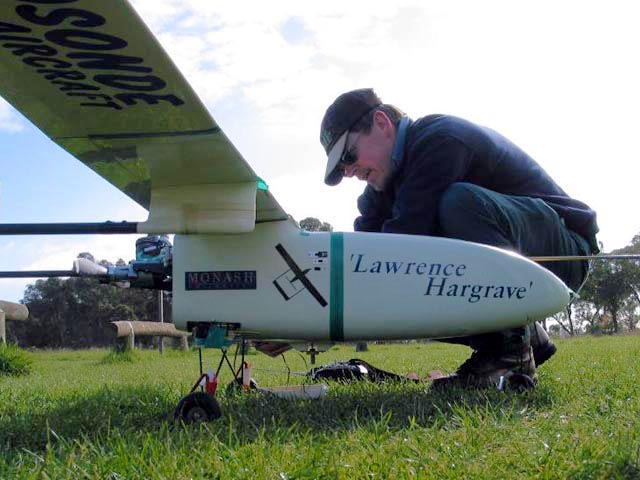
Horizon Sensing Attitude Stabiliser (HSAS) trials.
Aerosonde UAV 'Lawrence Hargrave' - video trials
September 21, 2002
Photography - Prof. John Bird and Dr Russell Naughton
Monash University Research Associate Brian Taylor has devised a horizon sensing attitude stabiliser (HSAS) suitable for a wide variety of UAVs. 1
For the purpose of trialling he is flying a traditional methanol glow plug engined model aircraft but the system is applicable to tactical UAVs, fast delta wings, flying wings or electric sailplanes.
Conventional gyro and accelerometer systems cannot sense the absolute attitude of an aircraft, they can only sense the rate of change in pitch, roll or yaw.
Gyro systems are relatively slow to recover from a bad attitude launch or an in-air software reset.
The horizon sensing attitude stabiliser calculates the exact position of the horizon, whether the UAV is flying inverted or normally or stationary in a few milliseconds.
It can very quickly command any aircraft back to straight and level flight, or a programmed balanced turn in less than 20 milliseconds.
Another research area is Human Factors where Brian Taylor has developed a very simple user interface allowing a non-pilot to safely fly the UAV with only a few minutes training.
Automatic takeoff and landings have been demonstrated and during flight the ground controller can turn, climb or descend by simple movement of a single control stick. The aircraft is kept within a safe flight envelope at all times by the on-board stabiliser.

Brian Taylor, pre-flight checks

Brian Taylor, pre-flight checks

Brian Taylor with (l) pilot Ray Cooper

Brian Taylor 'helping' Ray Cooper :-)

Brian Taylor, Prof. Greg Egan and Ray Cooper

A successful flight
L-R : Paul Jenkins, Prof. Greg Egan, Ray Cooper(hidden)
Brian Taylor and Terry Cornall
Now to UAV 'Lawrence Hargrave'

Pilot Ray Cooper makes some final pre-flight checks

Ian Reynolds and Ray Cooper in discussion

Ian Reynolds and Ray Cooper in discussion

The portable video control station
Prof. Greg Egan and Ian Reynolds

The portable video control station
Dr Andrew Price and Prof. Greg Egan (rear)
a visiting student, Terry Cornall and Ian Reynolds

At the end of the 'work' day
a little recreational flying time for Prof. Greg Egan
Horizon Sensing Attitude Stabiliser
Researchers at Monash have dusted off some early work done by NASA for stabilising satellites and applied the latest MEMS (Micro Electro Mechanical Systems) thermopiles and microcontrollers to bring the concept up to date.
Early infrared horizon sensors used bulky and insensitive lead sulphide and lead sulphide telluride infrared detectors. The TIROS weather satellite series launched from 1960 onwards used infrared horizon sensing to orient the cameras and antennae as the satellite orbited the earth.
Some background NASA papers can be found at http://aesd.larc.nasa.gov
References
- "Conceptual Design and Analysis of an Infrared Horizon Sensor with Compensation for Atmospheric Variability", A. Jalink, R. E. Davis, and J.A. Dodgen, NASA TND-6616, February, 1972.
- "A Limb Radiance Calculation Approach for Model Atmospheres Containing Horizontal Gradients of Temperature and Pressure", R.E. Davis, NASA TND-4905, October,1969.
- "Infrared Horizon Profiles for Winter Conditions from Project Scanner", R.I.Whitman, T.B. Mckee, and R.E. Davis, NASA TND- 4905, December, 1968.
- "Infrared Horizon Profiles for Summer Conditions from Project Scanner", T.B. McKee, R. I. Whitman, and R. E. Davis, NASA TND- 4741, August,1968.
- "Radiometric Measurements of the Earth's Infrared Horizon from the X-15 in Three Spectral Intervals", A. Jalink, R.E. Davis, and D. E. Hinton, NASA TND-4654, July, 1968.
- "Preliminary Infrared Horizon Profiles from Project Scanner", T. B. McKee, R. I Whitman, and R. E. Davis, NASA TMX-1483, December,1967.
|

